Deck 4: Force and Newtons Laws of Motion
Question
Question
Question
Question
Question
Question
Question
Question
Question
Question
Question
Question
Question
Question
Question
Question
Question
Question
Question
Question
Question
Question
Question
Question
Question
Question
Question
Question
Question
Question
Question
Question
Question
Question
Question
Question
Question
Question
Question
Question

Unlock Deck
Sign up to unlock the cards in this deck!
Unlock Deck
Unlock Deck
1/40
Play
Full screen (f)
Deck 4: Force and Newtons Laws of Motion
1
Three objects experience interactions. Object has mass, object has electrical charge, and object has both mass and electrical charge. Which of the following statements is true?
A) Object A and object B experience an electrical interaction.
B) Object and object experience a gravitational interaction.
C) Object and object experience a gravitational interaction.
D) Object and object experience an electrical interaction.
A) Object A and object B experience an electrical interaction.
B) Object and object experience a gravitational interaction.
C) Object and object experience a gravitational interaction.
D) Object and object experience an electrical interaction.
Object and object experience a gravitational interaction.
2
If an object of mass on Earth is sent to the Moon, it will have a mass of
A) .
B) .
C) .
D) .
A) .
B) .
C) .
D) .
.
3
A freight train consists of an engine and several identical cars on a straight, level track. Which of the following statements is true?
A) If the train is moving at constant speed, the engine must be pulling with a force greater than the train's weight.
B) If the train is moving at constant speed, the engine's pull on the first car must exceed that car's backward pull on the engine.
C) If the train is moving at constant speed, the engine's pull must be equal to the force of friction.
D) If the train is coasting, its inertia makes it slow down and eventually stop.
A) If the train is moving at constant speed, the engine must be pulling with a force greater than the train's weight.
B) If the train is moving at constant speed, the engine's pull on the first car must exceed that car's backward pull on the engine.
C) If the train is moving at constant speed, the engine's pull must be equal to the force of friction.
D) If the train is coasting, its inertia makes it slow down and eventually stop.
If the train is moving at constant speed, the engine's pull must be equal to the force of friction.
4
In the figure an airport luggage carrying train with a tractor is pulling three luggage carts , and , with constant velocity of . Unfortunately, the wheels on the carts have locked up and are sliding rather than rolling. If , and , and the coefficient of kinetic friction for each is 0.4000 , what is the force in the connection between the tractor and cart ? Use .

A)
B)
C)
D)
E)

A)
B)
C)
D)
E)

Unlock Deck
Unlock for access to all 40 flashcards in this deck.
Unlock Deck
k this deck
5
In the figure, an airport luggage carrying train with a tractor is pulling three luggage carts, , and , with constant velocity of . If , and (there is no friction), then the force in the connection between the tractor and cart is

A) .
B) .
C) .
D) .
E) .

A) .
B) .
C) .
D) .
E) .

Unlock Deck
Unlock for access to all 40 flashcards in this deck.
Unlock Deck
k this deck
6
A large massive rock is in contact with the Earth. Draw a force diagram for the rock and the Earth. Which of the following statements is true?
A) The gravitational force on the rock due to the Earth and the gravitational force on the Earth due to the rock are interaction partners.
B) The gravitational force on the Earth due to the rock and the contact force on the Earth due to the rock are interaction partners.
C) The gravitational force on the rock due to the Earth and the contact force on the Earth due to the rock are interaction partners.
D) The contact force on the Earth due to the rock and the gravitational force on the Earth due to the rock are interaction partners.
A) The gravitational force on the rock due to the Earth and the gravitational force on the Earth due to the rock are interaction partners.
B) The gravitational force on the Earth due to the rock and the contact force on the Earth due to the rock are interaction partners.
C) The gravitational force on the rock due to the Earth and the contact force on the Earth due to the rock are interaction partners.
D) The contact force on the Earth due to the rock and the gravitational force on the Earth due to the rock are interaction partners.

Unlock Deck
Unlock for access to all 40 flashcards in this deck.
Unlock Deck
k this deck
7
What is the gravitational field strength on the surface of the Earth? , the mass of the Earth is , and the radius of the Earth is .)
A) .
B) .
C) .
D) .
E) .
A) .
B) .
C) .
D) .
E) .

Unlock Deck
Unlock for access to all 40 flashcards in this deck.
Unlock Deck
k this deck
8
What is the gravitational field strength at the location of a satellite that is orbiting the Earth at an altitude of , the mass of the Earth is , and the radius of the Earth is .)
A) .
B) .
C)
D) .
E) .
A) .
B) .
C)
D) .
E) .

Unlock Deck
Unlock for access to all 40 flashcards in this deck.
Unlock Deck
k this deck
9
The gravitational field at the Moon due to the Earth is approximately ( , the mass of the Earth is , and the distance to the Moon is )
A) toward the Earth.
B) away from the Earth.
C) away from the Earth.
D) toward the Earth.
E) toward the Earth.
A) toward the Earth.
B) away from the Earth.
C) away from the Earth.
D) toward the Earth.
E) toward the Earth.

Unlock Deck
Unlock for access to all 40 flashcards in this deck.
Unlock Deck
k this deck
10
The gravitational field at the Earth due to the Moon is about ( , the mass of the Moon is , and the distance to the Moon is )
A) away from the Moon.
B) away from the Moon.
C) toward the Moon.
D) away from the Moon.
E) toward the Moon.
A) away from the Moon.
B) away from the Moon.
C) toward the Moon.
D) away from the Moon.
E) toward the Moon.

Unlock Deck
Unlock for access to all 40 flashcards in this deck.
Unlock Deck
k this deck
11
The Moon (mass ) orbits the Earth (mass ) at a distance of meters. Meanwhile, the Earth orbits the Sun (mass ) at a distance of meters. When the Moon is directly between the Earth and the Sun, what is the gravitational field at the location of the Moon due to the Earth and the Sun combined?
A) toward the Sun
B) toward the Earth
C) toward the Sun
D) toward the Earth
E) toward the Earth
A) toward the Sun
B) toward the Earth
C) toward the Sun
D) toward the Earth
E) toward the Earth

Unlock Deck
Unlock for access to all 40 flashcards in this deck.
Unlock Deck
k this deck
12
The Moon (mass ) is orbiting about the Earth (mass ) at a radius of meters. The magnitude of the force of gravity on the Moon due to the Earth is
A) .
B) .
C) .
D) .
E) .
A) .
B) .
C) .
D) .
E) .

Unlock Deck
Unlock for access to all 40 flashcards in this deck.
Unlock Deck
k this deck
13
An object with a mass of is above the surface of the Earth. The magnitude of the force of gravity on the mass is , the radius of the Earth is , and the mass of the Earth is )
A) .
B) .
C) .
D) .
E) .
A) .
B) .
C) .
D) .
E) .

Unlock Deck
Unlock for access to all 40 flashcards in this deck.
Unlock Deck
k this deck
14
What is the gravitational force between two masses that are apart from center to center? (G )
A)
B)
C)
D)
E)
A)
B)
C)
D)
E)

Unlock Deck
Unlock for access to all 40 flashcards in this deck.
Unlock Deck
k this deck
15
What is the gravitational force between two nuclei, each of mass , which are separated by a distance of
A)
B)
C)
D)
A)
B)
C)
D)

Unlock Deck
Unlock for access to all 40 flashcards in this deck.
Unlock Deck
k this deck
16
The weight of a object on the surface of the Moon is ( , the radius of the Moon is , and the mass of the Moon is )
A) .
B) .
C) .
D) .
E) .
A) .
B) .
C) .
D) .
E) .

Unlock Deck
Unlock for access to all 40 flashcards in this deck.
Unlock Deck
k this deck
17
The Moon (mass ) orbits the Earth (mass ) at a distance of meters. Meanwhile, the Earth orbits the Sun (mass ) at a distance of meters. When the Moon is directly between the Earth and the Sun, what is the gravitational force on the Moon due to the Earth and the Sun combined? ( )
A) toward the Earth
B) toward the Sun
C) toward the Earth
D) toward the Sun
E) toward the Earth
A) toward the Earth
B) toward the Sun
C) toward the Earth
D) toward the Sun
E) toward the Earth

Unlock Deck
Unlock for access to all 40 flashcards in this deck.
Unlock Deck
k this deck
18
A boy with a mass of walks into a room and sees a girl in front of him who has a mass of . What is his gravitational attraction to her?
A)
B)
C)
D)
E)
A)
B)
C)
D)
E)

Unlock Deck
Unlock for access to all 40 flashcards in this deck.
Unlock Deck
k this deck
19
A mass sits at rest on top of a table. Which two forces that are not action-reaction partners are equal and opposite?
A) the force of gravity on the mass due to the Earth and the contact force on the mass due to the table
B) the contact force on the mass due to the table and the force of gravity on the Earth due to the mass
C) the contact force on the mass due to the table and the contact force on the table due to the mass
D) the force of gravity on the mass due to the Earth and the contact force on the table due to the mass
E) the force of gravity on the mass due to the Earth and the force of gravity on the Earth due to the mass
A) the force of gravity on the mass due to the Earth and the contact force on the mass due to the table
B) the contact force on the mass due to the table and the force of gravity on the Earth due to the mass
C) the contact force on the mass due to the table and the contact force on the table due to the mass
D) the force of gravity on the mass due to the Earth and the contact force on the table due to the mass
E) the force of gravity on the mass due to the Earth and the force of gravity on the Earth due to the mass

Unlock Deck
Unlock for access to all 40 flashcards in this deck.
Unlock Deck
k this deck
20
Within a given system, the internal forces
A) determine the motion of the system.
B) are always balanced by the external forces.
C) all add to zero.
D) are measured with a gravimeter.
E) are only determined by subtracting the external forces from the net force on the system.
A) determine the motion of the system.
B) are always balanced by the external forces.
C) all add to zero.
D) are measured with a gravimeter.
E) are only determined by subtracting the external forces from the net force on the system.

Unlock Deck
Unlock for access to all 40 flashcards in this deck.
Unlock Deck
k this deck
21
A rope is connected to a spring scale on the left and exerts a force . Another rope is connected to the scale on the right and exerts a force . The scale shows a reading of . The values of and are

A) , and .
B) , and .
C) , and .
D) , and .

A) , and .
B) , and .
C) , and .
D) , and .

Unlock Deck
Unlock for access to all 40 flashcards in this deck.
Unlock Deck
k this deck
22
A box rests on a frictionless countertop. A boy pushes horizontally to the right on the box, and a girl pushes on it to the left, yet it remains stationary. Which of the following statements is false?
A) We know the force of the boy on the box is equal in magnitude to the force of the girl on the box, because the box is in equilibrium.
B) We know the weight and normal force are equal in magnitude because the box is in equilibrium.
C) We know the weight and normal force are equal in magnitude because of Newton's third law.
D) We know the force of the boy on the box is equal in magnitude to the force of the box on the boy, because of Newton's third law.
A) We know the force of the boy on the box is equal in magnitude to the force of the girl on the box, because the box is in equilibrium.
B) We know the weight and normal force are equal in magnitude because the box is in equilibrium.
C) We know the weight and normal force are equal in magnitude because of Newton's third law.
D) We know the force of the boy on the box is equal in magnitude to the force of the box on the boy, because of Newton's third law.

Unlock Deck
Unlock for access to all 40 flashcards in this deck.
Unlock Deck
k this deck
23
A tractor is pulling a trailer with a constant velocity. If the velocity is and and , then the force on the trailer due to the tractor is (assume there is no friction or air resistance)
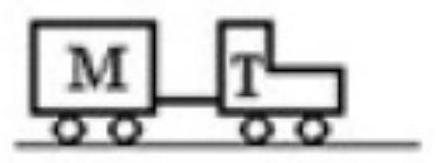
A) forward.
B) backward.
C) 0 .
D) forward.
E) backward.

A) forward.
B) backward.
C) 0 .
D) forward.
E) backward.

Unlock Deck
Unlock for access to all 40 flashcards in this deck.
Unlock Deck
k this deck
24
A tractor is pulling a trailer with a constant acceleration. If the forward acceleration is and and , then the force on the tractor due to the trailer is (ignore air resistance)
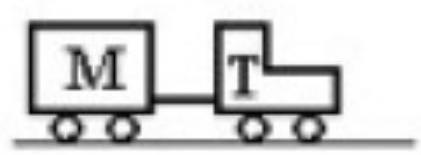
A) forward.
B) backward.
C) backward.
D) 0 .
E) forward.

A) forward.
B) backward.
C) backward.
D) 0 .
E) forward.

Unlock Deck
Unlock for access to all 40 flashcards in this deck.
Unlock Deck
k this deck
25
A tractor is pulling a trailer with a constant acceleration. If the forward acceleration is and and , then the horizontal force on the tractor due to the ground is (ignore air resistance)
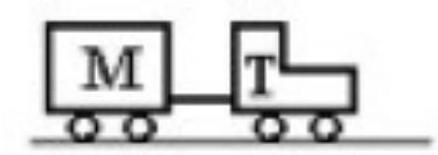
A) backward.
B) forward.
C) forward.
D) backward.
E) forward.

A) backward.
B) forward.
C) forward.
D) backward.
E) forward.

Unlock Deck
Unlock for access to all 40 flashcards in this deck.
Unlock Deck
k this deck
26
A tractor is pulling two trailers, and , with a constant acceleration. has a mass of has a mass of , and has a mass of . If the forward acceleration is , then the horizontal force on the tractor due to the ground is (ignore air resistance)

A) forward.
B) forward.
C) forward.
D) backward.
E) backward.

A) forward.
B) forward.
C) forward.
D) backward.
E) backward.

Unlock Deck
Unlock for access to all 40 flashcards in this deck.
Unlock Deck
k this deck
27
A tractor is pulling two trailers, and , with a constant acceleration. Thas a mass of has a mass of , and has a mass of . If the forward acceleration is , and air resistance is negligible, then the horizontal force on the tractor due to the attachment to is

A) backward.
B) forward.
C) backward.
D) forward.
E) forward.

A) backward.
B) forward.
C) backward.
D) forward.
E) forward.

Unlock Deck
Unlock for access to all 40 flashcards in this deck.
Unlock Deck
k this deck
28
A tractor is pulling two trailers, and , with a constant acceleration. Thas a mass of has a mass of , and has a mass of . If the forward acceleration is , and air resistance is negligible, then the horizontal force on due to the attachment to is

A) forward.
B) backward.
C) forward.
D) forward.
E) backward.

A) forward.
B) backward.
C) forward.
D) forward.
E) backward.

Unlock Deck
Unlock for access to all 40 flashcards in this deck.
Unlock Deck
k this deck
29
A tractor of mass is pulling a trailer of mass . If the tractor-trailer is accelerated at , and air resistance is negligible, then the tension in the trailer hitch that connects the trailer to the tractor is

A) .
B) .
C) .
D) .
E) .

A) .
B) .
C) .
D) .
E) .

Unlock Deck
Unlock for access to all 40 flashcards in this deck.
Unlock Deck
k this deck
30
A tractor of mass is pulling a trailer of mass . If the tractor-trailer is accelerated at , and air resistance is negligible, then the magnitude of the force the tractor applies to the road is

A)
B)
C) .
D) .
E)

A)
B)
C) .
D) .
E)

Unlock Deck
Unlock for access to all 40 flashcards in this deck.
Unlock Deck
k this deck
31
In the figure, an airport luggage-carrying train with a tractor is pulling three luggage carts, , and with an acceleration of . If , and , and air resistance is negligible, then the tension in the connection between cart and cart is

A) .
B) .
C) .
D) .
E) .

A) .
B) .
C) .
D) .
E) .

Unlock Deck
Unlock for access to all 40 flashcards in this deck.
Unlock Deck
k this deck
32
In the figure, an airport luggage-carrying train with a tractor is pulling three luggage carts, , and with an acceleration of . If , and , and air resistance is negligible, then the tension in the connection between cart and cart is

A)
B) .
C) .
D) .
E) .

A)
B) .
C) .
D) .
E) .

Unlock Deck
Unlock for access to all 40 flashcards in this deck.
Unlock Deck
k this deck
33
Two masses are suspended by a cord that passes over a pulley with negligible mass. The cord also has negligible mass. One of the masses, , has a mass of and the other mass, , has a mass of . The acceleration of is
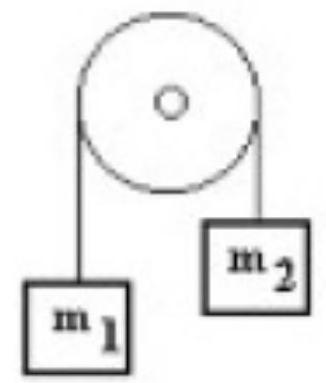
A) upward.
B) downward.
C) upward.
D) downward.
E) upward.

A) upward.
B) downward.
C) upward.
D) downward.
E) upward.

Unlock Deck
Unlock for access to all 40 flashcards in this deck.
Unlock Deck
k this deck
34
Two masses are suspended by a cord that passes over a pulley with negligible mass. The cord also has negligible mass. One of the masses, , has a mass of and the other mass, , has a mass of . The pulley turns on a shaft through the center of the pulley, which supports the pulley and all the masses. The vertical force of the shaft on the pulley is
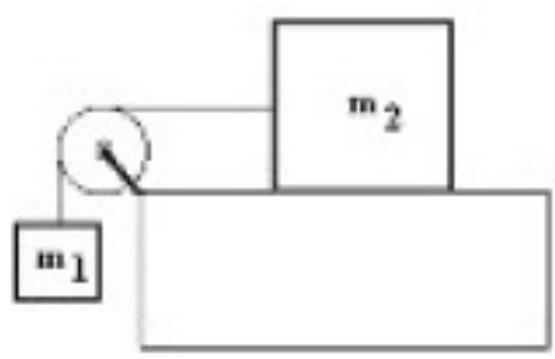
A) downward.
B) upward.
C) upward.
D) downward.
E) upward.

A) downward.
B) upward.
C) upward.
D) downward.
E) upward.

Unlock Deck
Unlock for access to all 40 flashcards in this deck.
Unlock Deck
k this deck
35
An person is riding in an elevator that is accelerating at downward. The apparent weight of the person measured on a scale in the elevator is
A) .
B) .
C) .
D) .
E) .
A) .
B) .
C) .
D) .
E) .

Unlock Deck
Unlock for access to all 40 flashcards in this deck.
Unlock Deck
k this deck
36
A object is travelling due north at when it begins to experience a constant net force of 1.72 toward the south. What will its velocity be later?
A) , north.
B) , north.
C) , south
D) , north
E) , south.
F) , south
A) , north.
B) , north.
C) , south
D) , north
E) , south.
F) , south

Unlock Deck
Unlock for access to all 40 flashcards in this deck.
Unlock Deck
k this deck
37
An object travels toward the west. Under the influence of a constant net force of , after , it is travelling toward the east. What is its mass?
A)
B)
C)
D)
A)
B)
C)
D)

Unlock Deck
Unlock for access to all 40 flashcards in this deck.
Unlock Deck
k this deck
38
Two masses are connected by a string which passes over a pulley with negligible mass and friction. One mass hangs vertically and one mass slides on a 30.0 degree incline. The inclined surface has a coefficient of kinetic friction of 0.200 . The vertically hanging mass is and the mass on the incline is . The magnitude of the acceleration of the mass is (the initial velocity of the mass is down the incline)
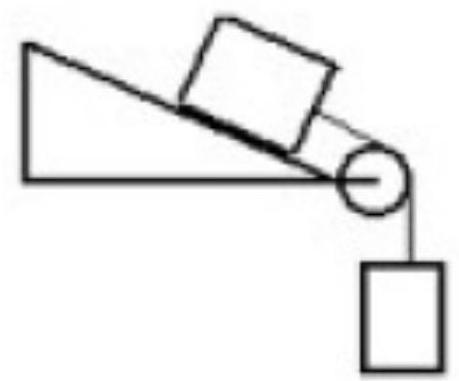
A) .
B) .
C) .
D) .
E) .

A) .
B) .
C) .
D) .
E) .

Unlock Deck
Unlock for access to all 40 flashcards in this deck.
Unlock Deck
k this deck
39
Two masses are connected by a string which passes over a pulley with negligible mass and friction. One mass hangs vertically and one mass slides on a 30.0 degree incline. The inclined surface has a coefficient of kinetic friction of 0.200 . The vertically hanging mass is and the mass on the incline is . The magnitude of the acceleration of the mass is (the initial velocity of the mass is down the incline)
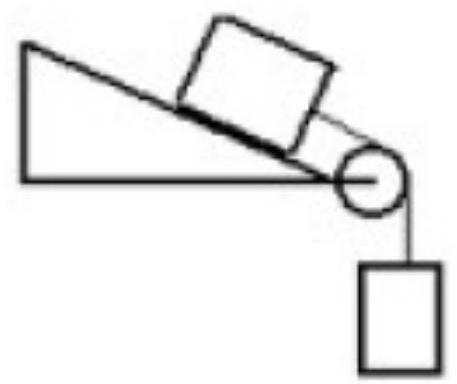
A) .
B) .
C) .
D) .
E) .

A) .
B) .
C) .
D) .
E) .

Unlock Deck
Unlock for access to all 40 flashcards in this deck.
Unlock Deck
k this deck
40
Two masses are connected by a string which passes over a pulley with negligible mass and friction. One mass hangs vertically and one mass slides on a horizontal surface. The horizontal surface has a coefficient of kinetic friction of 0.200 . The vertically hanging mass is and the mass on the horizontal surface is . The magnitude of the acceleration of the vertically hanging mass is (the initial velocity of the horizontal mass is to the right)
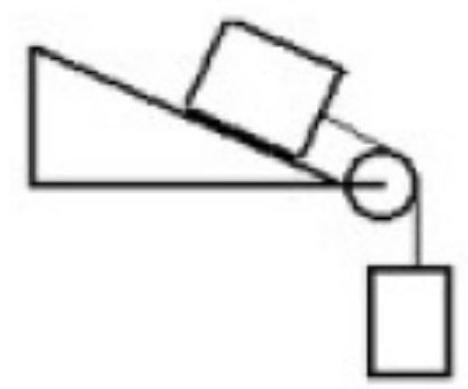
A) .
B) .
C) .
D) .
E) .

A) .
B) .
C) .
D) .
E) .

Unlock Deck
Unlock for access to all 40 flashcards in this deck.
Unlock Deck
k this deck



